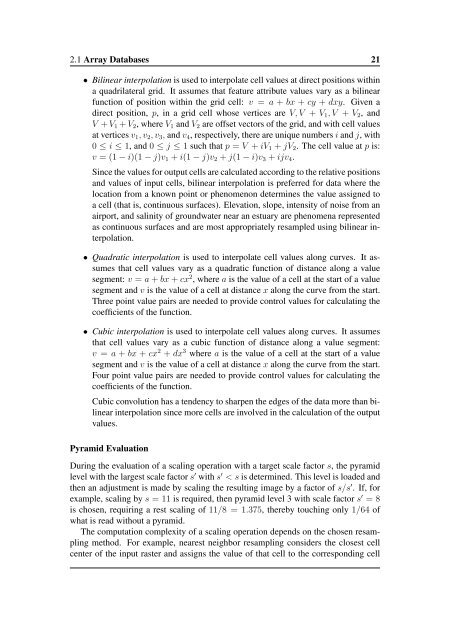Applying OLAP Pre-Aggregation Techniques to ... - Jacobs University
Applying OLAP Pre-Aggregation Techniques to ... - Jacobs University
Applying OLAP Pre-Aggregation Techniques to ... - Jacobs University
You also want an ePaper? Increase the reach of your titles
YUMPU automatically turns print PDFs into web optimized ePapers that Google loves.
2.1 Array Databases 21<br />
• Bilinear interpolation is used <strong>to</strong> interpolate cell values at direct positions within<br />
a quadrilateral grid. It assumes that feature attribute values vary as a bilinear<br />
function of position within the grid cell: v = a + bx + cy + dxy. Given a<br />
direct position, p, in a grid cell whose vertices are V, V + V 1 , V + V 2 , and<br />
V + V 1 + V 2 , where V 1 and V 2 are offset vec<strong>to</strong>rs of the grid, and with cell values<br />
at vertices v 1 , v 2 , v 3 , and v 4 , respectively, there are unique numbers i and j, with<br />
0 ≤ i ≤ 1, and 0 ≤ j ≤ 1 such that p = V + iV 1 + jV 2 . The cell value at p is:<br />
v = (1 − i)(1 − j)v 1 + i(1 − j)v 2 + j(1 − i)v 3 + ijv 4 .<br />
Since the values for output cells are calculated according <strong>to</strong> the relative positions<br />
and values of input cells, bilinear interpolation is preferred for data where the<br />
location from a known point or phenomenon determines the value assigned <strong>to</strong><br />
a cell (that is, continuous surfaces). Elevation, slope, intensity of noise from an<br />
airport, and salinity of groundwater near an estuary are phenomena represented<br />
as continuous surfaces and are most appropriately resampled using bilinear interpolation.<br />
• Quadratic interpolation is used <strong>to</strong> interpolate cell values along curves. It assumes<br />
that cell values vary as a quadratic function of distance along a value<br />
segment: v = a + bx + cx 2 , where a is the value of a cell at the start of a value<br />
segment and v is the value of a cell at distance x along the curve from the start.<br />
Three point value pairs are needed <strong>to</strong> provide control values for calculating the<br />
coefficients of the function.<br />
• Cubic interpolation is used <strong>to</strong> interpolate cell values along curves. It assumes<br />
that cell values vary as a cubic function of distance along a value segment:<br />
v = a + bx + cx 2 + dx 3 where a is the value of a cell at the start of a value<br />
segment and v is the value of a cell at distance x along the curve from the start.<br />
Four point value pairs are needed <strong>to</strong> provide control values for calculating the<br />
coefficients of the function.<br />
Cubic convolution has a tendency <strong>to</strong> sharpen the edges of the data more than bilinear<br />
interpolation since more cells are involved in the calculation of the output<br />
values.<br />
Pyramid Evaluation<br />
During the evaluation of a scaling operation with a target scale fac<strong>to</strong>r s, the pyramid<br />
level with the largest scale fac<strong>to</strong>r s ′ with s ′ < s is determined. This level is loaded and<br />
then an adjustment is made by scaling the resulting image by a fac<strong>to</strong>r of s/s ′ . If, for<br />
example, scaling by s = 11 is required, then pyramid level 3 with scale fac<strong>to</strong>r s ′ = 8<br />
is chosen, requiring a rest scaling of 11/8 = 1.375, thereby <strong>to</strong>uching only 1/64 of<br />
what is read without a pyramid.<br />
The computation complexity of a scaling operation depends on the chosen resampling<br />
method. For example, nearest neighbor resampling considers the closest cell<br />
center of the input raster and assigns the value of that cell <strong>to</strong> the corresponding cell
















